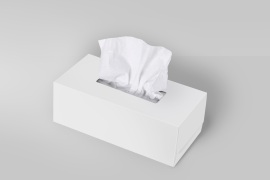Paperboard boxes for cosmetic tissues are convenient for consumers, but sometimes challenging for producers: the delicate paperboard boxes are subjected to considerable stress when the tissues are pulled out. Thermographic inspection systems from edevis therefore ensure that the adhesive seams are present and correctly positioned. The containers are inspected inline in the glued state within a tenth of a second. Defective ones are sorted out. In general, adhesive, sealant or coating inspections are predestined applications for thermographic methods.
The application:
In a packaging line, thin blanks of paperboard are folded into small boxes and glued. The adhesive application should be checked for presence and correct positioning. Since the paperboard box is already glued, the seam to be checked is hidden inside. The adhesive application could also be checked in the open state, but only after the two surfaces have come together is it certain that the adhesive has been applied correctly. Thermography is therefore well suited for this inspection because it can record the heat imprint of the adhesive through the paperboard in a positionally accurate manner and compare it with the sample image. As a result, it can automatically decide within the cycle time whether the bond is OK (IO) or not OK (NIO).
The task:
The task was to develop an inline test stand with an automated thermographic inspection process for the handkerchief containers. The test had to be integrated into the existing production line. The manufacturer wanted to be able to sort out defective containers at the earliest possible stage to avoid unnecessary losses. Defective parts must be sorted out in time before the next station in the process.
The challenge:
The particular challenge was the cycle time of around 10 boxes per second. In the process, 6 glued seams are inspected per container, 3 on each side. Two infrared cameras are used, whose data are processed simultaneously in real time. The edevis hardware and software is thus able to perform the evaluation of the glued seam within 10 ms, and to give a signal for the immediate subsequent sorting out of defective parts.
The solution:
In order to meet the high challenges, crucial optimizations were made by edevis in the configuration of the hardware and software. System-side latencies in data processing were reduced to accommodate the cycle time. In doing so, the software application was docked as close as possible to the “real-time core” of the operating system in Windows. The two infrared cameras, positioned to the right and left of the tape, were a proprietary development, since the infrared cameras available on the market, against the background of a favorable cost specification, did not meet the processing speed requirements (see also our blog article on edeCAM). Even at high speed, the inspection system accurately detects whether the adhesive application has spread correctly and whether the opposite side has also docked. It thus fulfills an important test requirement, namely to rule out any undesired springback of the other side of the bond. Since both (hot) bonding processes and paper fibers cannot be standardized in all parameters with process reliability, thermographic adhesive application testing is important after bonding has been completed.
The project planning:
The Japanese customer provided samples, which were used for a feasibility test. A quotation was then prepared. The technical implementation was carried out together with the sales partner KEN Automation and the manufacturer of the packaging line. The connection to the higher-level control system was made via fieldbus, in this case Profi.NET, but other systems such as OPC OA or 24V I/O lines are also possible.
The Machine Learning:
A central aspect of the project comes to the topic of machine learning, a precursor to artificial intelligence (AI). The test system learns which adhesive seam is OK (IO) or not OK (NIO) from the order through the teach-in process. The customer can train this inspection independently by first producing and inspecting good parts under controlled conditions. The inspection system thus learns what good parts look like and can detect and sort out deviations from this. Once this learning process has been completed in a stable manner, undesirable deviations in the production process can be quickly detected and corrected.
Wherever pasty to liquid substances are applied with heat imprint, thermographic testing can provide good services. It is therefore suitable for industrial bonding, packaging technology, painting, coating, for industrial sealants, plastic bonding, industrial resins food, and much more.
